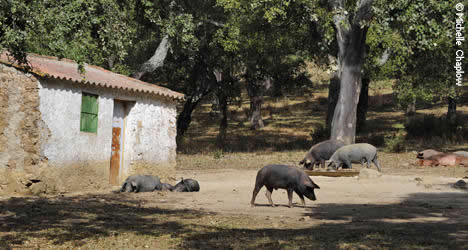
Last week, the Spanish government approved a new colour-coding system for Iberian pork products.
Jamon iberico is probably the most popular and highly-prized food in Spain, and nowhere more so than here in Andalucia, where the Sierra de Aracena produces first-class cured ham from acorn-fed black-hoofed pure-bred Iberian pigs - the famous pata negra. Prohibitively expensive (a kilo costs between around 40 and 70 euros), jamon iberico is internationally renowned as a "star produce of Spanish gastronomy," said the Agriculture Minister Miguel Arias Cañete at a press conference to announce the new grading system. For many, Spanish jamon iberico is simply the best in the world.
The previous rules for labelling jamon iberico, and other Iberian pork products, were confusing, leaving consumers unsure of what quality of ham they were buying. But some labelling was also actively misleading - a label showing a happy pig grazing contentendly on acorns (which produce the white fat and sweet taste) didn't neccessarily mean that the animal had been allowed to roam on the dehesa (savannah-like open woodland), nibbling bellotas (acorns) under oak trees.
As well as mislabelling, the amount of "jamon iberico de bellota" on sale didn't tally with how many acorn-fed Iberian pigs were being reared. The number of pure-bred Iberian pigs in Spain has dropped substantially during the crisis, with fewer than 115,000 being produced in 2011, down nearly 60% on 2008's figures. This is as compared to over 2.5 million Iberian (mixed-breed) pigs. So as well as ensuring that only genuinely acorn-fed pure-bred Iberian ham is labelled as such, another aim of the new rules is preserving the Iberian breed itself.

Spain's finest ham comes from these acorn-fed Iberian pigs in the Sierra de Aracena. Photo: Michelle Chaplow
There are two DOs (Denominacion de Origen) of jamon iberico in Andalucia: Jamon de Huelva and Los Pedroches (Cordoba). In the Alpujarras, the village of Trevelez is famous for its ham made from white pigs, but they don't come under this system as it's only for ibericos.
The new system makes jamon iberico product labels much simpler, so you know exactly what you're buying - what the animal was fed on and where, and its breeding. The labelling takes into account three main factors:
- The breed of pig: The Iberian pig, the small brown breed native to Spain, is the finest jamon producer. Some pigs will be 100% Iberian, with both parents pure-bred. Others will be part Iberian mixed with another breed - mother pure Iberian and father mixed; the percentage of Iberian must be specified so its exact genealogy can be traced.
- What it was fed on: There are now three categories, down from four: bellota (acorns), cebo del campo (natural grazing), or cebo (fodder).
- Where it was raised: Allowed to roam free (eating acorns or grazing naturally), or kept enclosed in a pen (and fed fodder). When being raised free-range, the number of pigs allowed per hectare is 0.25-1.25. For those in captivity, pigs weighing over 110kg must have a minimum of 2 square meters each.
These are the colour-coded labels:
BLACK LABEL - Jamon 100% Iberico de Bellota
This is the top category - the finest available - and indicates a pure-bred Iberian pig
which has been fed only on acorns during the montanero period (October to February).
It is free-range, being allowed to roam around the dehesa.
RED LABEL - Jamon Iberico de Bellota
This is a pig which is part-Iberian - the percentage of Iberian breed must be specified.
The pig has been allowed to roam free, eating acorns.
GREEN LABEL - Jamon Iberico de Cebo de Campo
This pig is at least 50% Iberian and has been allowed to roam freely, eating both natural
grazing and fodder.
WHITE LABEL - Jamon Iberico de Cebo
This pig is at least 50% Iberian and has been kept enclosed in a pen and given fodder.
Another aspect of Iberian pork products which will be more tightly controlled under the new law is the length of time ham is cured for, and a minimum weight of leg will be introduced.
The system also applies to paleta (smaller front legs - jamon is typically the hind leg) and caña de lomo (loin) made from Iberico pigs.
Images, logos, and symbols will be limited to avoid the sort of misrepresentations mentioned above - pictures of acorns and dehesa can only be used on the label for an Iberian pig which actually ate bellotas and roamed on this type of land.
The labelling will come into force gradually; all newly produced Iberian hams will have to bear the colour-coded labels, but those products already on sale will not. So until all existing ham products are sold, some will remain that aren't coded as per the new system.